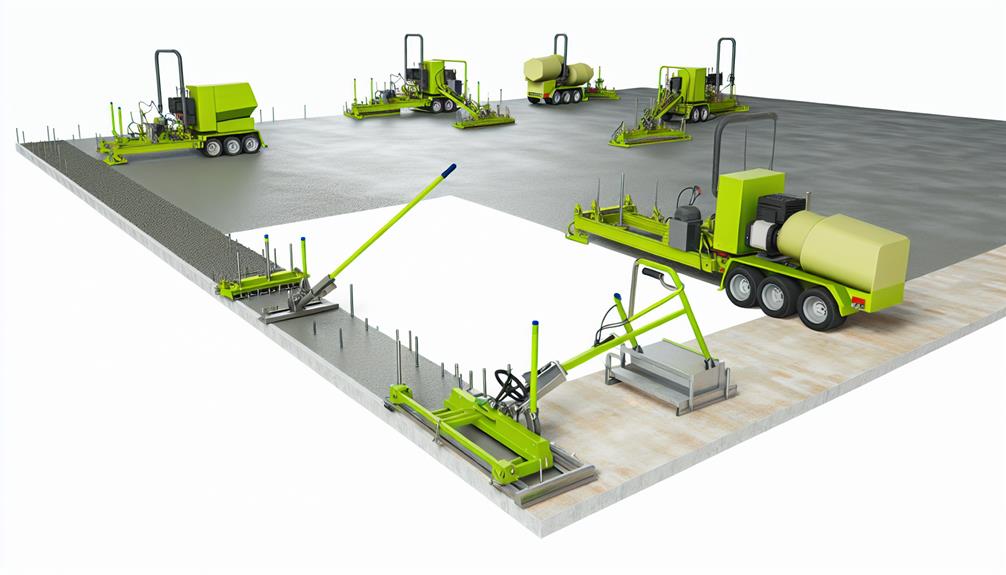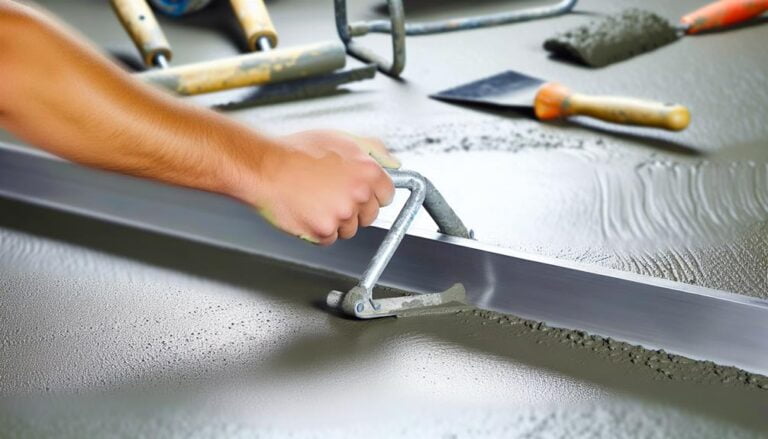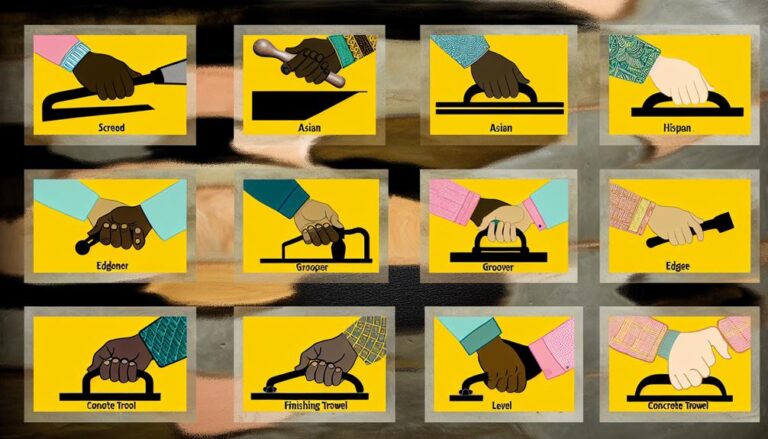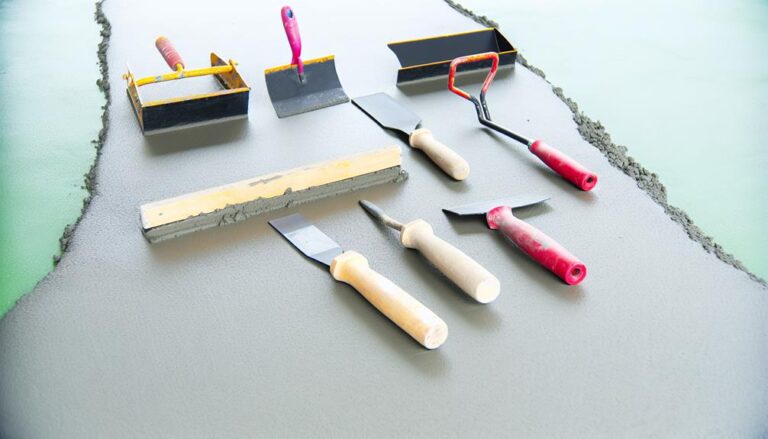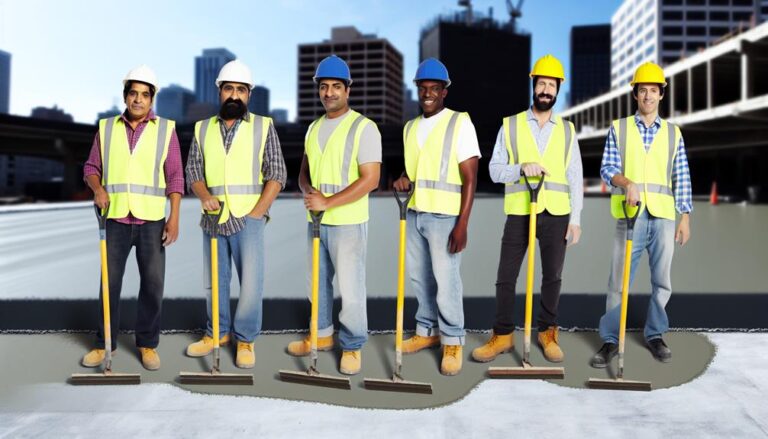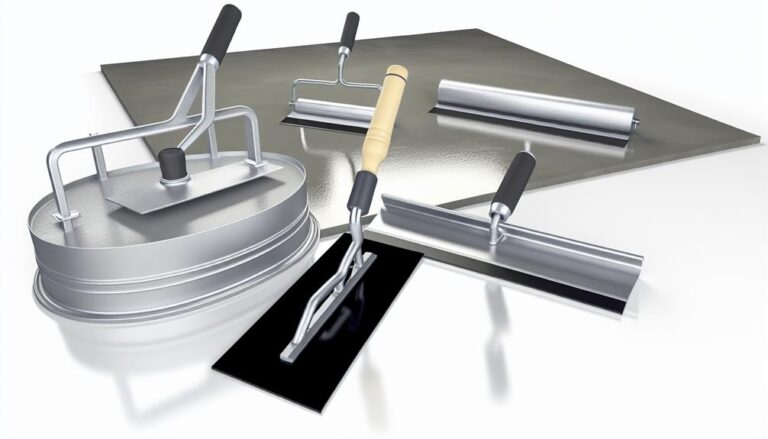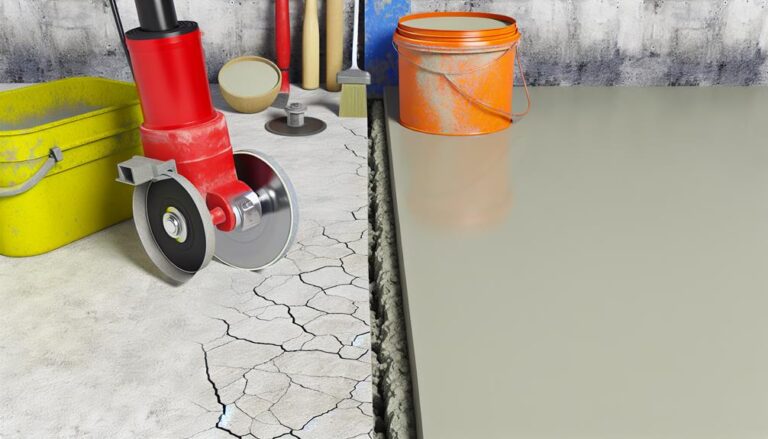Top Concrete Leveling Techniques & Equipment: FAQ
Top concrete leveling techniques include self-leveling using compounds, mudjacking, and polyurethane foam jacking. These ensure your driveways, sidewalks, and patios are even and safe. It's important to clean and prime surfaces before starting. The job should be done with care, using tools like a concrete leveler, screed, float, and grinder. Be sure to wear protective gear when handling these tools! Each method and tool has its pros and cons considering cost, durability, and ease of use. Navigate further to understand which technique suits your needs best and to step up your concrete work game!
Understanding Concrete Leveling
Before diving into the methods and equipment used in concrete leveling, it's crucial to grasp what concrete leveling actually is and why it's so important in construction. Concrete leveling is a process that corrects uneven concrete surfaces by altering the foundation that the surface sits upon. It's primarily a method of repair for sunken or tilted driveways, sidewalks, and patios.
You might wonder why concrete settles in the first place. Well, the most common culprits are shifts in the soil underneath. Over time, soil can compact, causing the concrete above to sink and become uneven. This not only looks unappealing, but it's also a safety hazard, increasing the risk of trips and falls.
Concrete leveling solves this problem. It's an efficient and cost-effective way to fix concrete surfaces without having to replace them entirely. The procedure involves injecting a material, like a cementitious mixture or polyurethane foam, beneath the concrete slab to raise it back to its original position. It's a job for professionals, so don't try this at home. It requires expertise and the right equipment to ensure a smooth and level surface.
Importance of Surface Preparation
Proper surface preparation is a critical step you can't afford to skip in the concrete leveling process. This task ensures that the new layer of concrete adheres well to the existing surface. Without it, you'll likely experience problems such as cracking, bubbling, or peeling down the line.
Before you even think about pouring new concrete, you need to clean the existing surface thoroughly. Remove any debris, dust, or loose particles that might interfere with the bonding process. You should also be mindful of any oil or grease stains, as these can prevent the new layer of concrete from sticking properly.
Next, consider the condition of the existing surface. If it's uneven or damaged, you may need to repair it before proceeding. This might involve filling cracks or holes, or sanding down any high spots. Remember, the goal is to create a solid, even base for the new layer of concrete.
Lastly, don't forget to prime the surface. A good concrete primer can significantly improve the adhesion between the old and new layers of concrete. So, don't skimp on this step. If you do, you're setting yourself up for failure.
Self-Leveling Concrete Technique
Now, let's dive into the self-leveling concrete technique, a method that can give you a perfectly flat and smooth surface with minimal effort. This technique uses a self-leveling compound, a type of high-flow cement that spreads across a surface, filling in low spots as it goes.
To begin, you'll clean the surface thoroughly. You can't have any debris, dirt, or dust mucking up your work. Once that's done, you'll apply a primer. This ensures the compound adheres correctly and strengthens the bond between the old and new layers.
Next, you'll mix the self-leveling compound according to the manufacturer's instructions. Remember, it's vital to get the consistency right. Too thick, and it won't spread properly; too thin, and it mightn't level correctly.
Then comes the application. Pour the compound onto the surface, starting from one end and working your way to the other. Use a gauge rake to help it spread evenly. It's a quick process, as the compound begins to set within minutes.
With the self-leveling technique, you're essentially letting the concrete do all the work. It's an efficient method that can save you time and energy, leaving you with a perfectly level surface.
Mudjacking: An Overview
While the self-leveling technique lets the concrete do the work, mudjacking offers another efficient method for leveling uneven concrete surfaces.
You might ask, what's mudjacking? It's a process where a mixture of water, soil, sand and cement, known as 'slurry,' is injected beneath the concrete slab. This slurry fills the voids and raises the slab to its original level.
Don't worry about the mess; it's not as dirty as it sounds. The holes drilled for injection are small, typically one to two inches in diameter, and are patched up afterwards. It's a cost-effective method, often cheaper than replacing the entire slab. Plus, it's quick, typically taking only a few hours.
However, it's not all rosy. Mudjacking has its downsides. The added weight of the slurry can cause further sinking if the soil beneath isn't stable. It's also not as long-lasting as some other methods.
Polyurethane Foam Jacking Method
Stepping away from the messier mudjacking process, let's dive into the cleaner, more modern technique of polyurethane foam jacking. This method, popular for its efficiency and precision, uses high-density polyurethane foam to lift and stabilize concrete.
With polyurethane foam jacking, you'll first drill small holes into the concrete slab. Then, using special equipment, you'll inject the foam into these holes. As the foam expands, it fills the voids underneath the slab, effectively lifting and leveling the concrete. This process is quick, often completed in just a few hours, and the foam hardens rapidly allowing immediate use of the treated area.
While it's more expensive than mudjacking, the benefits of foam jacking are substantial. It's less invasive, doesn't require large drill holes, and it's waterproof, preventing future erosion. Notably, the lightweight nature of the foam reduces the risk of overburdening the soil.
Polyurethane foam jacking is a versatile method, suitable for sidewalks, driveways, pool decks, and more. Its precision makes it an excellent choice for correcting uneven concrete. Remember, though, it's crucial to employ trained professionals to ensure a safe and effective process.
Grinding and Polishing Techniques
In addition to leveling, your concrete might need a bit of grinding and polishing, techniques that give it a smooth, appealing finish. After your concrete has been leveled, grinding comes into play. You'll use a concrete grinder, a powerful tool that uses abrasive materials to smooth down rough concrete surfaces. This process doesn't just beautify your concrete; it also prepares it for further treatments like sealing or staining.
Next up is the polishing process. Concrete polishing involves a series of steps where you progressively grind the concrete surface with different grits of diamond resin pads. You'll start with a coarse pad and gradually switch to finer ones. This process is akin to sanding a piece of wood, and the result is a glossy, mirror-like finish that's both attractive and low-maintenance.
But remember, grinding and polishing your concrete requires both precision and patience. You can't rush it, or you'll risk damaging the surface. And while you can certainly tackle this job yourself, hiring a professional might be a wise investment, especially if you're dealing with large areas or want a specific finish. They'll have the experience, equipment, and knowledge to ensure your concrete looks its best.
Slabjacking: A Detailed Analysis
After you've perfected the aesthetics of your concrete through grinding and polishing, you might find that it's time to address any unevenness or sinking issues, and that's where slabjacking comes into play. Also known as mudjacking, this technique involves pumping a mixture of water, soil, sand, and cement underneath the slab to raise it back to its original level.
You might wonder why you should opt for slabjacking. Well, it's a cost-effective and efficient method for leveling concrete. It's less invasive than other techniques, causing minimal disruption to your property. It's also eco-friendly, using natural materials and reducing the need for new concrete.
However, it's not a DIY job. Slabjacking requires professional expertise to ensure the mixture is correctly prepared and pumped under the slab at the right points. Failure to do this can result in further damage to your concrete.
Essential Concrete Leveling Tools
Wondering what tools you'll need for a concrete leveling job? They're not as complicated as you might think. To ensure a smooth and level surface, you'll need the right equipment.
The first essential tool is a concrete leveler. It helps you distribute the concrete evenly across the surface. Next, you'll need a screed to remove excess concrete and create a flat, even surface. Additionally, a float is used to smooth out the concrete after it's been screeded. Lastly, you'll need a concrete grinder to smooth and level the hardened concrete surface.
Let's summarize these essentials in a table:
| Tool | Function |
|---|---|
| Concrete Leveler | Distributes concrete evenly |
| Screed | Removes excess concrete |
| Float | Smoothens the concrete surface |
| Concrete Grinder | Levels the hardened surface |
Pros and Cons of Concrete Leveling Methods
Now, let's dive into the advantages and disadvantages of different concrete leveling methods.
Firstly, there's mudjacking, a process where a mud mixture is pumped beneath the concrete to raise it. You'll find it's cheap and quick, but it's not the most durable option. It's also quite messy, and you'll have larger holes to patch up afterwards.
Then you've got polyurethane foam injection. It's a more advanced technique that offers an even, long-lasting lift. It's less messy and the holes needed are smaller. But, it's more expensive than mudjacking and the foam can sometimes be tricky to control.
Finally, there's grinding and polishing. This is a great option for minor imperfections and smoothing out surfaces. It's fast and cost-effective. However, it's not suitable for severe level issues and it can expose the aggregate of your concrete, which may not be ideal.
All in all, each method has its own strengths and weaknesses. It really depends on your specific situation. Don't forget to weigh up the pros and cons, and consult a professional if you're unsure. After all, you want your concrete to be level and look its best.
Safety Measures in Concrete Leveling
When leveling concrete, it's crucial to prioritize safety and take necessary precautions to prevent accidents. Even though the process may seem straightforward, if not handled correctly, it can lead to significant injuries or property damage.
Here are some safety measures you should consider:
- Wear Protective Gear: Always put on safety glasses, gloves, and sturdy footwear when handling concrete. This will protect you from sharp objects, chemical burns, and other potential hazards.
- Proper Handling of Equipment: Make sure you're well-versed in operating the concrete leveling equipment. Misusing or mishandling these tools can lead to severe injuries, so it's essential you're trained properly.
- Secure the Work Area: Keep the area where you're working clear of unnecessary objects or debris. This helps to prevent trips, falls, or other accidents.
Frequently Asked Questions
What Is the Cost Comparison Between Different Concrete Leveling Techniques?
When comparing costs of different concrete leveling techniques, it's not a one-size-fits-all answer. The cost can vary greatly depending on the technique used.
Mudjacking might be cheaper initially, but requires more material and maintenance. Polyurethane foam injection, while costlier upfront, can provide long-term stability.
It's best to consult with a professional to understand which method is most cost-effective for your specific needs.
Are There Any Environmental Considerations to Take Into Account When Choosing a Concrete Leveling Method?
Absolutely, environmental considerations are crucial when choosing a concrete leveling method.
Did you know that slabjacking, for example, uses a mixture that's 100% recyclable?
It's important to consider the environmental footprint of the materials used, as well as any potential soil disruption.
Moreover, look into the equipment's energy efficiency.
You've got options that prioritize sustainability, so make sure to ask providers about their environmental impact.
How Long Does It Usually Take for Each Concrete Leveling Technique to Dry or Cure?
You're curious about the drying or curing time for different concrete leveling techniques, right?
Well, it varies. Mudjacking, for instance, typically takes a day to cure. Polyurethane foam leveling, on the other hand, can cure in as little as 15 minutes!
It's all about the method you choose. Remember to consult your contractor for specifics, as conditions like weather and humidity can affect drying times, too.
Can Any of These Concrete Leveling Techniques Be Used for Decorative Purposes?
Absolutely, some concrete leveling techniques can be used decoratively! You can transform a drab concrete slab into a work of art.
Techniques like concrete engraving, etching, and staining can create beautiful designs. Even self-leveling overlays can offer a sleek, polished aesthetic.
What Is the Process for Maintaining and Repairing Leveled Concrete Over Time?
You're right to consider maintenance after leveling your concrete. It's crucial to regularly inspect for cracks or signs of sinking. If you spot trouble, immediate repair is necessary. Techniques include sealant application or additional leveling.
Cleaning is also vital – remove debris and apply a quality concrete sealer. Always follow manufacturer's instructions for any repair products. Professional advice can ensure longevity for your newly leveled concrete surface.
Conclusion
So there you have it, you're now well-versed in the art of concrete leveling. It's no walk in the park, but with the right tools and techniques, it can be as smooth as a well-leveled slab.
Keep in mind, every method has its highs and lows, so choose wisely. And don't forget, safety's never a level to overlook.
So gear up and dive into the world of concrete leveling – it's a solid foundation for any construction endeavor.
